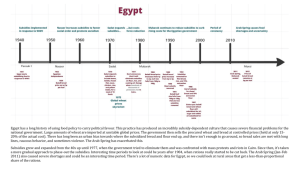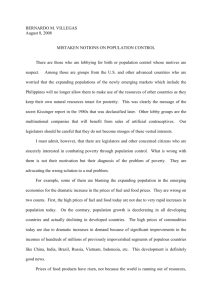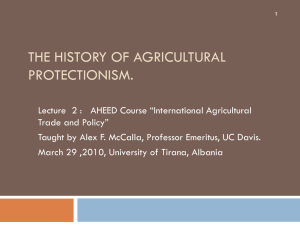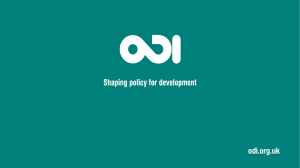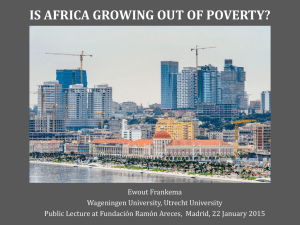COVER 7 - Third World Network
advertisement
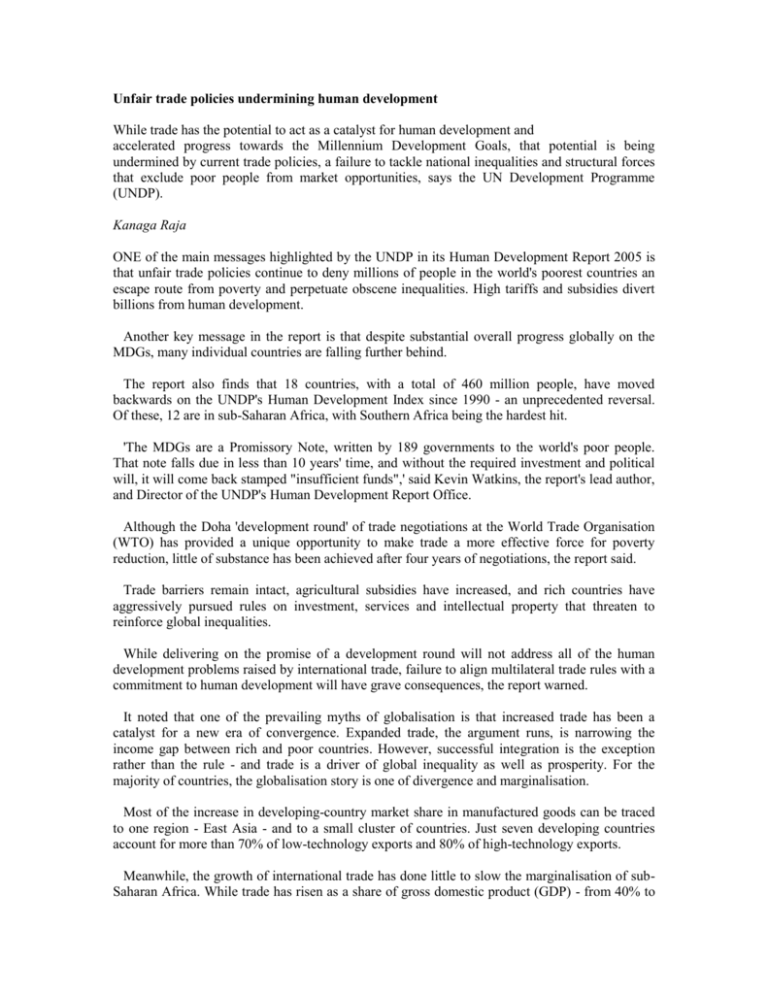
Unfair trade policies undermining human development While trade has the potential to act as a catalyst for human development and accelerated progress towards the Millennium Development Goals, that potential is being undermined by current trade policies, a failure to tackle national inequalities and structural forces that exclude poor people from market opportunities, says the UN Development Programme (UNDP). Kanaga Raja ONE of the main messages highlighted by the UNDP in its Human Development Report 2005 is that unfair trade policies continue to deny millions of people in the world's poorest countries an escape route from poverty and perpetuate obscene inequalities. High tariffs and subsidies divert billions from human development. Another key message in the report is that despite substantial overall progress globally on the MDGs, many individual countries are falling further behind. The report also finds that 18 countries, with a total of 460 million people, have moved backwards on the UNDP's Human Development Index since 1990 - an unprecedented reversal. Of these, 12 are in sub-Saharan Africa, with Southern Africa being the hardest hit. 'The MDGs are a Promissory Note, written by 189 governments to the world's poor people. That note falls due in less than 10 years' time, and without the required investment and political will, it will come back stamped "insufficient funds",' said Kevin Watkins, the report's lead author, and Director of the UNDP's Human Development Report Office. Although the Doha 'development round' of trade negotiations at the World Trade Organisation (WTO) has provided a unique opportunity to make trade a more effective force for poverty reduction, little of substance has been achieved after four years of negotiations, the report said. Trade barriers remain intact, agricultural subsidies have increased, and rich countries have aggressively pursued rules on investment, services and intellectual property that threaten to reinforce global inequalities. While delivering on the promise of a development round will not address all of the human development problems raised by international trade, failure to align multilateral trade rules with a commitment to human development will have grave consequences, the report warned. It noted that one of the prevailing myths of globalisation is that increased trade has been a catalyst for a new era of convergence. Expanded trade, the argument runs, is narrowing the income gap between rich and poor countries. However, successful integration is the exception rather than the rule - and trade is a driver of global inequality as well as prosperity. For the majority of countries, the globalisation story is one of divergence and marginalisation. Most of the increase in developing-country market share in manufactured goods can be traced to one region - East Asia - and to a small cluster of countries. Just seven developing countries account for more than 70% of low-technology exports and 80% of high-technology exports. Meanwhile, the growth of international trade has done little to slow the marginalisation of subSaharan Africa. While trade has risen as a share of gross domestic product (GDP) - from 40% to 55% since 1990 - the region's share (excluding South Africa) of world exports has fallen to 0.3%. Today, with a population of 689 million people, the region accounts for a smaller share of world exports than Belgium, with just 10 million people. If Africa had maintained the share of world exports that it enjoyed in 1980, its exports today would be some $119 billion higher. That is equivalent to about five times aid flows and budget savings from debt service relief provided by high-income countries in 2002. Stressing the human development and wider economic gains to be made from trade, the report however challenged the claim that increased trade offers automatic benefits, contrasting the success of Vietnam to the problems faced by Mexico. Greater openness in Mexico has been associated with negligible reductions in poverty and high levels of inequality, with rapid import liberalisation in agriculture further marginalising the rural poor. In Vietnam, from far lower levels of average income, openness has contributed to accelerated human development, partly because its export success has been built on domestic reforms that have generated economic growth with equity and partly because it has not pursued greater openness through rapid import liberalisation. 'Perverse taxation' While acknowledging the benefits of import liberalisation as part of a wider strategy for poverty reduction and increased growth, the report argues that the design, pace and sequencing of reform is critical for a liberalisation strategy to work. It said that although the rich countries have consistently pledged to reduce tariffs on imports from developing countries and to greatly slash their subsidies through programmes such as the US' African Growth and Opportunity Act, neither goal has been achieved. The report decries what it calls 'perverse taxation' where the world's highest trade barriers are erected against some of its poorest countries. On average, the trade barriers faced by developing countries exporting to rich countries are three times higher than those faced by rich countries when they trade with each other. For example, while the average tariff on imports from developing countries to high-income countries is 3.4%, Japan imposes a tariff of 26% on Kenyan footwear, while the EU taxes Indian garment imports at 10%. Developing countries account for less than one-third of developed-country imports but for twothirds of tariff revenues collected. They also account for two-thirds of developed-country imports subjected to tariffs higher than 15%. Vietnam, for instance, pays $470 million in taxes on exports to the US worth $4.7 billion, while the UK pays roughly the same amount on exports worth $50 billion. Tariff escalation is one of the more pernicious forms of perverse graduation, the report notes, pointing for example to the fact that in Japan, tariffs on processed food products are seven times higher than on first-stage products. In Canada, they are 12 times higher. This tariff structure prevents developing countries from adding value to their exports and helps explain why 90% of the world's cocoa beans are grown in developing countries, while only 44% of cocoa liquor and 29% of cocoa powder exports originate in these countries. In addition to facing high tariff barriers in developed countries, developing countries impose high barriers on trade with each other, the report said, adding for example that average tariffs on low- and middle-income countries exporting to South Asia are more than 20%. The report contends that instead of keeping a promise made in the last round of world trade negotiations, developed countries have actually increased agricultural subsidies. These 'subsidies for overproduction in developed countries' have now reached $1 billion a day, compared with $1 billion a year for agricultural aid to developing countries. Developed-country support to agricultural production amounts to $350 billion a year. While some political leaders in developed countries seek to justify agricultural support by reference to rural development objectives and the interests of vulnerable communities, the report countered that there is little evidence to support this justification. In the real world, the winners in the annual cycle of multi-billion-dollar subsidies are large-scale farmers, corporate agri-business interests and landowners. Today, developing countries lose about $24 billion a year from agriculture protectionism and subsidies. For every $1 lost in trade, there is a multiplier effect that causes losses worth an additional $3 from reduced investment and employment. This could put total losses at about $72 billion, an amount equivalent to all official aid flows in 2003. Nothing demonstrates better the perverse logic of agricultural subsidies than the EU's Common Agricultural Policy (CAP) - an arrangement that lavishes $51 billion in support to producers. CAP supports a sector that accounts for less than 2% of employment but absorbs more than 40% of the total EU budget. EU sugar farmers, for example, are paid four times more than the world market price and this in turn creates a four-million-ton surplus of sugar that is dumped on the world market with the help of $1 billion in EU marketing support. This surplus has caused world sugar prices to tumble by about one-third, costing Brazil $494 million in lost revenues, $151 million for South Africa and $60 million for Thailand. Another example is the cotton policy adopted by the US, where it has been estimated that the country's 20,000 cotton farmers will receive government payments of $4.7 billion in 2005 - an amount equivalent to the market value of the crop and more than US aid to sub-Saharan Africa. The adjustment costs borne by other countries have been high. In 2001 - when world cotton prices fell to a 50-year low - losses attributed to US subsidies were estimated at 1-3% of GDP for Burkina Faso and Mali in West Africa, a region where some two million smallholders depend on cotton as their main source of income. In Benin alone, the fall in prices in 2001 was linked to an increase in poverty from 37% to 59%. The report stressed that since the Doha round started, the US has passed legislation that increases agricultural support by about $7 billion a year, while under measures agreed in 2003, the EU has created a framework that will restructure, but not reduce, overall support - the CAP budget is set to increase over the next decade. Compounding the problem of unfair trade rules is the fact that the value of primary commodities has fallen as a total of world trade, from 15% to 10% since 1980. In the late 1980s, coffee exporters received about $12 billion for their exports but in 2003, they exported more coffee, but received less than half as much. On the other hand, the 'coffee economy' in rich countries is booming, with retail sales now reaching $80 billion a year. Other areas The report also highlights four other areas that will have a major bearing on human development - industrial policy, intellectual property, services and tariffs and revenue. One of the most pressing challenges for developing countries is to develop the capacity to enter higher value-added areas of world trade, and in this respect, an active industrial and technology policy is a critical requirement. However, several WTO agreements limit the policy space available to governments, the report said, citing as examples the Agreement on Subsidies and the Trade-Related Investment Measures (TRIMs) Agreement. To be successful, industrial policy needs to focus on dynamic new sectors, offer time-bound import protection and promote activities that generate investments and technological dispersion. Intellectual property rules also have an important bearing on human development, the report noted, adding that the WTO Agreement on Trade-Related Aspects of Intellectual Property Rights (TRIPS), along with 'TRIPS-plus' variants in regional and bilateral agreements, strike the wrong balance between the interests of technology holders and the wider public interest. The human development threats posed by the TRIPS Agreement are especially pronounced in public health, where strengthened intellectual property rules will delay the entry of generic drugs, driving up prices. One estimate for India suggests that costs to households associated with higher prices for medicines will increase by some $670 million. While liberalisation of trade in services offers potential benefits to developing countries, the problem is that industrial countries have focussed on areas that threaten to undermine human development prospects. Developed countries have concentrated their efforts almost exclusively on commercial presence while the developing countries have prioritised other areas, notably reducing barriers to temporary movement of labour. Although in some cases liberalisation of services does offer benefits, it is best managed through national strategies rooted in planning for the MDGs and wider human development goals, and not through multilateral trade rules. This is especially the case in areas such as water, health and education. The starting point for any WTO regime should be a full assessment of the human development implications of the rules on a sector-by-sector basis. 'Strengthening the links between trade and human development will require action across a broad front,' the report said, adding that the next ministerial meeting of the WTO in December presents a 'critical opportunity'. Binding schedules should be agreed upon to eliminate tariff peaks and reduce tariffs to no more than twice the average tariff by 2010; implement the proposal of the UK-sponsored Commission for Africa to apply duty-free and quota-free access to all exports from sub-Saharan Africa and extend this access to all least-developed countries (LDCs); relax rules of origin by adopting before 2007 legislation based on international best practice to reduce the value-added requirement for eligible products to 25% of export value and allow countries receiving preferences to source inputs from anywhere in the world; and establish in 2006 a trade adjustment compensation fund providing $500 million a year for the next decade to compensate countries for preference erosion. In agriculture, immediate priorities for a schedule of commitments by developed countries should provide for a binding prohibition on all direct export subsidies by 2007; a reduction in overall subsidies by 2010 to a level no higher than 10% of the value of production; compensation for developing-country producers affected by developed-country agricultural policies in key commodities such as sugar and cotton; phased reduction in import tariffs through the so-called Swiss formula, which makes the deepest cuts on the highest tariffs, with a ceiling of 10% by 2010; and an end to Blue Box provisions that allow countries to provide unlimited market-based support. Moreover, developed countries should agree to limit reciprocal demands for market access in non-agricultural goods, allowing developing countries to reduce average tariffs through a formula that allows a high degree of flexibility; and exempt 'special products' in agriculture from any requirement to liberalise, and permit developing countries to apply safeguard mechanisms to restrict market access when import levels threaten food security. Other recommendations made by the report include protection of policy space for human development and a commitment to avoid 'WTO-plus' arrangements in regional trade agreements. Falling further behind Another key message in the report has been that while there has been substantial overall progress globally on the MDGs, many individual countries are actually falling further behind. In the midst of an increasingly prosperous global economy, 10.7 million children every year do not live to see their fifth birthday and more than one billion people survive in abject poverty on less than $1 a day. The report estimated a cost of $300 billion for lifting one billion people living on less than $1 a day above the extreme poverty line threshold - that amount represents 1.6% of the income of the richest 10% of the world's population. Among its findings in relation to the MDGs are that 50 countries with a combined population of almost 900 million are falling backwards on at least one of the Goals, with 24 of these in subSaharan Africa; another 65 countries with a combined population of 1.2 billion risk failing to meet at least one Goal until after 2040; in 2015, on current trends, there would be 827 million people living in extreme poverty - 380 million more than if the agreed target to cut poverty was reached; in 2015, 47 million children would still be out of school, 19 million of them in subSaharan Africa; and on current trends, the goal to reduce the deaths of children under five years of age would be met in 2045, not 2015. The report argued that extreme inequality is a brake on progress towards the MDGs and wider human development goals. The scale of the international wealth divide is such that the poorest 40% of the world's population - 2.5 billion people, living on less than $2 a day - account for just 5% of all global income. Newly promised increases in aid for the world's poorest countries are significant and will help the fight against poverty, but still more and better assistance to the poor is needed to meet the MDGs. While noting that donors at the G8 summit of major industrial nations in Gleneagles in July made commitments to provide an additional $50 billion in aid over the next decade, the report said that some of the world's richest countries are still among the least generous donors. Germany and Italy have to substantially revise current aid spending plans if they are to meet the EU target of aid-to-GNI gross national income) ratio of 0.51% by 2010. Japan and the US, without further increases in aid, will still be spending only 0.18% of GNI on aid in 2010. The report cautioned that extra aid will not help achieve the MDGs unless donor countries also reform the way they provide aid. Poor countries often receive aid that is unpredictable, uncoordinated, hedged with conditions that do not reflect internal reform dynamics, and tied to purchases in donor countries. Weak donor coordination, a preference for operating outside the government systems and excessive reporting requirements have the effect of driving up transaction costs and reducing aid effectiveness. Donor countries also undermine the effectiveness of their own development programmes by tying aid to the purchase of their own products. Such arrangements cost developing countries up to 20% more than buying the same goods on the open market, the equivalent of a tax on aid of between $5-7 billion a year. International funds such as the Global Fund to Fight AIDS, Tuberculosis and Malaria and other multilateral initiatives are a valuable alternative. The report made several proposals for improving foreign aid, including setting a schedule for an aid-to-GNI ratio of 0.7% by 2015; provide predictable, multi-year financing through government programmes; streamlining conditionalities; ending tied aid; and tackling unsustainable debt. The report also highlighted the terrible human cost of violent conflicts in poor countries as well as the way in which poverty provides a breeding ground for further violence. Since 1990, developing countries have accounted for more than half of all armed conflicts, with nearly 40% taking place in Africa alone. It found that countries with an annual per capita income of $250 are twice as likely to descend into civil war as those with an annual per capita income of $600. It made several key policy recommendations, including aid for conflict-prone countries; integrated approach to collective security; building regional capacity; cutting the flow of small arms; and greater transparency in managing natural resources. Kanaga Raja is a researcher with the Third World Network. The above article first appeared in the South-North Development Monitor (SUNS, No. 5870, 12 September 2005).

